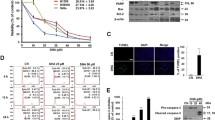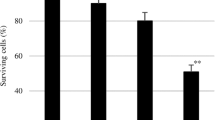Abstract
Objective
Docosahexaenoic acid (DHA) is known as a chemopreventive substance for cancers. Previously we reported that DHA induces apoptosis in HL-60 cells. The aim of this study was to clarify the role of phosphatidylinositol 3-kinase (PI3-kinase)/Akt signaling during DHA-induced apoptosis in HL-60 cells.
Methods
The inhibitory effects of dibutyryl cAMP (db-cAMP) or LY294002 (a specific inhibitor of the PI3-kinase/Akt pathway) on DHA-induced apoptosis in HL-60 cells were evaluated by the appearance of apoptosis, and from the activities of caspases (3 and 8), the phospholylation of Akt, and cleavage of Bid using DNA indexes, emzymatic measurement of fragmented substrates, and Western blotting, respectively.
Results
The pre-incubation of db-cAMP reduced the activation of caspasses (3 and 8) during the occurrence of DHA-induced apoptosis in HL-60. However, the inhibition of PI3-kinase/Akt signaling by LY294002 resulted in recovery of the caspases’ activities, appearance of apoptotic cells, and cleavage of the Bid molecule when LY294002 was co-treated with db-cAMP before the occurrence of DHA-induced apoptosis in HL-60. It was also confirmed that LY294002 strongly inhibited phospholylation of Akt during db-cAMP induced-reduction of DHA-induced apoptosis in HL-60.
Conclusion
We demonstrated that DHA-induced apoptosis was sensitive to the modulation of PI3-kinase activity by treatment with db-cAMP or LY294002. These results may provide new insights into the mechanisms of the anti-cancer activity of DHA.
Similar content being viewed by others
References
Rao VC, Hirose Y, Indranie C, Reddy SB. Modulation of experimental colon tumorigenesis by types and amounts of dietary fatty acids. Cancer Res. 2001; 61: 1927–1933.
Latham P, Lund KE, Johnson TI. Dietary n-3 PUFA increases the apoptotic response to 1,2-dimethylhydrazine, reduces mitosis and suppresses the induction of carcinogenesis in the rat colon. Carcinogenesis. 1999; 20: 645–650.
Akbar M, Kim H. Protective effects of docosahexaenoic acid in staurosporine-induced apoptosis: involvement of phosphatidylinositol-3 kinase pathway. J Neurochem. 2002; 82: 655–665.
Calviello G, Palozza P, Piccioni E, Maggiano N, Frattucci A, Franceschelli P, Bartoli MG. Dietary supplementation with eicosapentaenoic and docosahexaenoic acid inhibits growth of morris hepatocarcinoma 3924A in rats: effects on proliferation and apoptosis. Int J Cancer. 1998; 75: 699–705.
Scheid MP, Lauener RW, Duronio V. Role of phosphatidylinositol 3-OH-kinase activity in the inhibition of apoptosis in haemopoietic cells: phosphatidylinositol 3-OH-kinase inhibitors reveal a difference in signaling between interleukin-3 and granulocyte-macrophage colony stimulating factor. Biochem J. 1995; 312: 159–162.
Minshall C, Arkins S, Freund GG, Kelley KW. Requirement for phosphatidylinositol 3′-kinase to protect hemopoietic progenitors against apoptosis depends upon the extracellular survival factor. J Immunol. 1996; 156: 939–947.
Songyang Z, Baltimore D, Cantley LC, Kaplan DR, Franke TF. Interleukin 3-dependent survival by the Akt protein kinase. Proc Natl Acad Sci USA. 1997; 94: 11345–11350.
Cynthia RLW, Anwer MS. Cyclic adenosine monophosphate-mediated protection against bile acid-induced apoptosis in cultured rat hepatocytes. Hepatology. 1998; 27: 1324–1331.
Scheid MP, Foltz IN, Young PR, Schrader JW, Duronio V. Ceramide and cyclic adenosine monophosphate (cAMP) induce cAMP response element binding protein phosphorylation via distinct signaling pathways while having opposite effects on myeloid cell survival. Blood. 1999; 93: 217–225.
Li M, Wang X, Meintzer MK, Laessig T, Birnbaum MJ, Heidenreich KA. Cyclic AMP promotes neuronal survival by phosphorylation of glycogen synthase kinase 3β. Mol Cell Biol. 2000; 20: 9356–9363.
Yusta B, Boushey RP, Drucker DJ. The glucagons-like peptide-2 receptor mediates direct inhibition of cellular apoptosis via a cAMP-dependent protein kinase-independent pathway. J Biol Chem. 2000; 275: 35345–35352.
Kim SN, Ahn Y-H, Kim SG, Park SD, Cho-Chung YS, Hong SH. 8-C1-cAMP induces cell cycle-specific apoptosis in human cancer cells. Int J Cancer. 2001; 93: 33–41.
Xia Z, Dickens M, Raingeaud J, Davis RJ, Greenberg ME. Opposing effects of ERK and JNK-p38 MAP kinase on apoptosis. Science. 1995; 270: 1326–1331.
Arita K, Kobuchi H, Utsumi T, Takehara Y, Akiyama J, Horton AA, Utsumi K. Mechanism of apootosis in HL-60 cells induced by n-3 and n-6 polyunsaturated fatty acids. Biochem Pharmacol. 2001; 62: 821–828.
Miura Y, Takahara K, Murata Y, Utsumi K, Tada T, Takahata K. Docosahexaenoic acid induces apoptosis via the Bax-independent pathway in HL-60 cells. Biosci Biotechnol Biochem. 2004; 68: 2415–2417.
Zang L, Himi T, Morita I, Murota S. Inhibition of phosphatidylinositol-3 kinase/Akt or mitogen-activated protein kinase signaling sensitizes endothelial cells to TNF-alpha cytotoxicity. Cell Death Differ. 2001; 8: 528–536.
Kluck RM, Esposti MD, Perkins G, Renken C, Kuwana T, Bossy-Wetzel E, Goldberg M, Allen T, Barber MJ, Green DR, Newmeyer DD. The pro-apoptotic proteins. Bid and Bax. cause a limited permeabilization of the mitochondrial outer membrane that is enhanced by cytosol. J Cell Biol. 1999; 4: 809–822.
Strokin M, Sergeeva M, Reiser G. Docosahezaenoic acid and arachidonic acid release in rat brain astrocytes is mediated by two separate isoforms of phospholipase A2 and is differently regulated by cyclic AMP and Ca2+. Br J Pharmacol. 2003; 139: 1014–1022.
Engler MM, Engler MB, Pierson DM, Molteni LB, Molteni A. Effects of docosahexaenoic acid on vascular pathology and reactivity in hypertension. Exp Biol Med. (Maywood) 2003; 228: 299–307.
Datta SR, Dudek H, Tao X, Masters S, Fu H, Gotoh Y, Greenberg ME. Akt phosphorylation of BAD couples survival signals to the cell-intrinsic death machinery. Cell. 1997; 91: 231–241.
Pawan K, April IM, Peter JP. p38 MAPK mediates γ-irradiation-induced endothelial cell apoptosis, and vascular endothelial growth factor protects endothelial cells through the phosphoinositide 3-kinase-Akt-Bcl-2 pathway. J Biol Chem. 2004; 279: 43352–43360.
Sawada M, Nakashima S, Banno Y, Yamakawa H, Takenaka K, Shinoda J, Nishimura Y, Sakai N, Nozawa Y. Influence of Bax or Bcl-2 overexpression on the ceramide-dependent apoptotic pathway in glioma cells. Oncogene. 2000; 19: 3508–3520.
Gallagher R, Collins S, Trujillo J, McCredie K, Ahearn M, Tsai S, Metzgar R, Aulakh G, Ting R, Ruscetti, F, Gallo R. Characterization of the continuous, differentiating mycloid cell line (HL-60) from a patient with acute promyelocytic leukemia. Blood. 1979; 54: 713–733.
Author information
Authors and Affiliations
Corresponding author
Rights and permissions
About this article
Cite this article
Miura, Y., Murata, Y., Utsumi, K. et al. The inhibitory effect of dibutyryl cyclic AMP on docosahexaenoic acid-induced apoptosis in HL-60 cells through activation of the phosphatidylinositol-3 kinase pathway. Environ Health Prev Med 10, 184–189 (2005). https://doi.org/10.1007/BF02897709
Received:
Accepted:
Issue Date:
DOI: https://doi.org/10.1007/BF02897709




